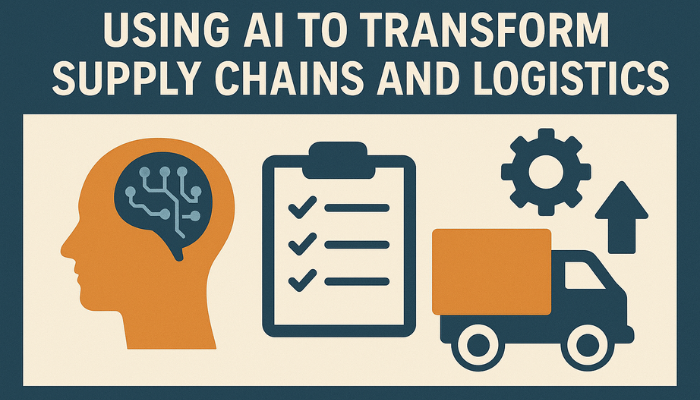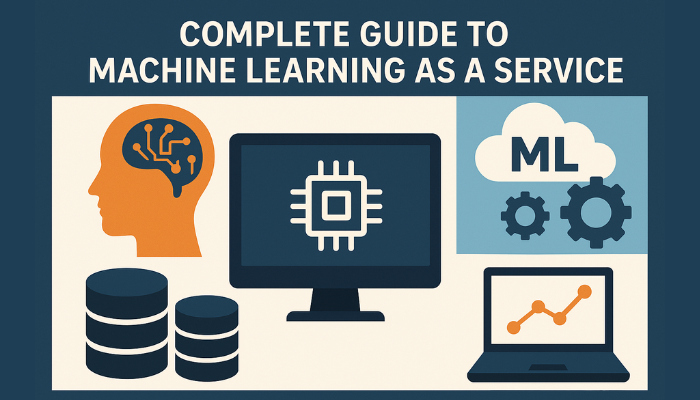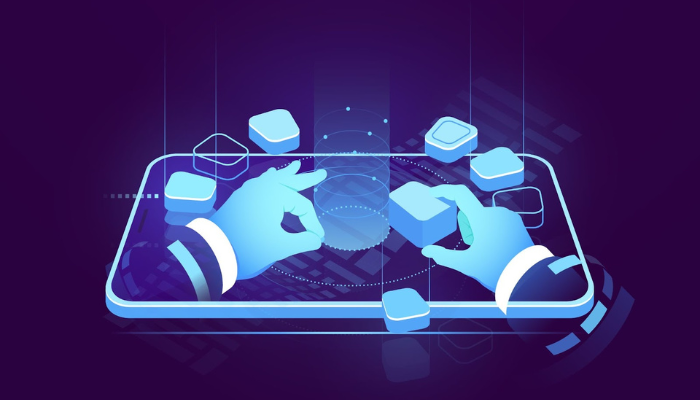Every decision you make in your supply chain impacts cost, customer trust, and long-term growth. But with rising disruptions, labor shortages, and growing customer expectations, traditional systems just can’t keep up. That’s why leading businesses are turning to artificial intelligence to gain the speed, insight, and precision needed to stay competitive.
In fact, the AI in logistics market in the US is expected to reach $26.34 billion by 2025, according to The Business Research Company, driven by the urgent need for real-time visibility and smarter, automated decision-making in increasingly complex logistics networks.
In this blog, you’ll get a clear view of AI in logistics and supply chain management, what it is, and how it works. We’ll cover the top tools, benefits, challenges, and steps to adopt AI successfully. If you’re ready to modernize your supply chain, this blog is for you.
What Is Artificial Intelligence in Logistics and Supply Chain?
AI in logistics and supply chain management refers to the use of smart technologies like machine learning, data analytics, and automation to improve how supply chains operate. AI systems analyze large sets of real-time and historical data to support better decision-making across various stages, such as demand forecasting, inventory planning, route optimization, warehouse operations, and supplier coordination.
Also Read: AI’s Role in Boosting Operational Efficiency
Knowing what AI is just the first step. Let’s explore how it actually works across different stages of the supply chain to solve real business challenges.
How AI Works Across the Supply Chain
Your supply chain is only as strong as the insights and decisions behind it. AI enhances each part of the process with real-time data and smart automation. Here is how it works across the supply chain:
1. Smarter Demand Forecasting and Inventory Planning
AI gives you deep visibility into future demand so you can make better inventory decisions.
- Advanced Forecasting Models: AI combines historical sales, seasonal trends, weather patterns, and even social media data to predict demand more accurately than traditional methods.
- Dynamic Inventory Adjustments: Instead of relying on fixed schedules, AI lets you adjust inventory levels in real time based on actual demand signals.
- Stock Optimization: You can avoid overstocking and stockouts, saving storage costs and ensuring you always have the right products available.
- Increased Profit Margins: Accurate forecasts reduce excess inventory and product waste, protecting your bottom line.
2. Real-Time Logistics and Transportation Optimization
AI helps you manage routes and shipping decisions more effectively, reducing costs and delivery times.
- Intelligent Route Planning: Machine learning models choose the most efficient delivery paths, factoring in traffic, weather, fuel prices, and road closures.
- Live Shipment Tracking: You get real-time updates on delivery status and location, giving full control over what’s happening on the road.
- Delay Forecasting and Alerts: AI flags potential disruptions early, like customs delays or carrier issues, so you can reroute or reschedule with minimal impact.
- Optimal Carrier Selection: AI evaluates carriers based on past performance, costs, and reliability to help you choose the best delivery partners every time.
3. Warehouse Automation and Efficiency
AI-powered automation turns your warehouse into a high-performing, round-the-clock operation.
- Automated Picking and Packing: Robotics powered by AI handles repetitive tasks like picking, sorting, and packaging with speed and accuracy, reducing labor costs and errors.
- Scalable Operations: AI systems quickly adapt to demand spikes, like holiday seasons or product launches, without needing extra manual labor.
- Workflow Optimization: AI analyzes how goods move through your warehouse and suggests layout changes or process improvements to reduce congestion and speed up throughput.
- Energy and Space Management: AI tracks energy usage and shelf space to maximize resource efficiency.
4. Data-Driven Supplier Management
AI supports smarter sourcing and stronger supplier relationships by analyzing real-time data and trends.
- Performance Monitoring: AI reviews supplier delivery times, quality records, and responsiveness to help you measure who’s adding value, and who’s not.
- Risk Scoring: Financial health, geopolitical risks, and regulatory issues are factored into AI-generated risk scores, helping you avoid supply chain disruptions.
- Automated Compliance Checks: AI reviews supplier contracts and certifications to flag missing documents or expired credentials.
- Enhanced Collaboration: AI platforms improve communication by suggesting ideal reorder points and alerting both you and suppliers about changes instantly.
5. End-to-End Visibility and Risk Prediction
AI gives you complete transparency and foresight across your supply chain.
- Integrated Data Streams: By collecting data from GPS (Global Positioning System), RFID (Radio-Frequency Identification), IoT (Internet of Things) sensors, and third-party sources, AI builds a full, real-time view of goods, people, and processes.
- Predictive Disruption Detection: AI spots early signs of issues like supplier delays, demand shifts, or political instability and suggests preventive actions.
- Smart Dashboards: Interactive visual tools highlight urgent issues, forecast risks, and help you take proactive steps instead of reacting too late.
- Better Customer Promises: With higher visibility, you can give accurate delivery timelines and meet customer expectations consistently.
6. Sustainability Monitoring and Compliance
AI helps align your supply chain with ESG goals and environmental regulations.
- Carbon Tracking: AI systems measure emissions at each supply chain stage, including transportation, warehousing, and production.
- Waste Reduction Suggestions: AI identifies areas to cut excess packaging, reduce energy use, or recycle unused inventory.
- Regulatory Compliance Checks: Stay ahead of new laws and standards by letting AI track and report on compliance metrics automatically.
- Circular Supply Chain Support: AI helps predict product returns and plan reverse logistics, so items can be reused, refurbished, or recycled efficiently.
7. Office Task Automation and Workflow Simplification
AI makes your back-office processes lean, accurate, and fast.
- Robotic Process Automation (RPA): AI bots handle routine tasks like invoice entry, purchase order creation, and shipment updates with minimal human input.
- Fewer Errors, Faster Approvals: Automation reduces mistakes in paperwork and speeds up internal processes, saving time and money.
- Unified Data Updates: AI ensures real-time syncing across your systems, keeping finance, operations, and customer teams on the same page.
8. Predictive Equipment Maintenance
AI keeps your supply chain equipment running without unexpected breakdowns.
- Continuous Monitoring: AI uses IoT sensors to track machine health, temperature, vibration, and usage levels.
- Failure Prediction: Algorithms detect early warning signs and alert your team before a breakdown happens.
- Automated Scheduling: AI sets up maintenance windows that fit your operation schedule to avoid disruptions.
- Extended Equipment Lifespan: Preventive actions reduce wear and tear, making your assets last longer and perform better.
Can’t Find a Tech Solution That Truly Fits Your Operations?
Most tools aren’t built for your unique process, and trying to make them fit only creates more friction. Codewave co-builds custom AI solutions that match how you work, not the other way around.
Talk to an Expert and let’s design a smart, scalable system just for your supply chain.
Understanding how AI functions is one thing, but what really matters is how it helps you operate better, faster, and smarter. Let’s explore the key benefits you can expect.
Benefits of Using AI in Supply Chain Operations
The following are some of the most valuable ways AI can improve your supply chain operations, helping you work faster, reduce costs, and stay ahead of disruption.
1. Faster and Informed Decision-Making
AI quickly turns complex data into clear, actionable insights. This speeds up decision-making and allows your team to shift focus from reacting to planning strategically.
2. Complete Supply Chain Visibility
With AI, you get a real-time, end-to-end view of inventory, shipments, and supplier activity, all in one place, so you can detect and resolve issues before they cause delays.
3. Accurate Demand Forecasting and Inventory Control
AI analyzes patterns and external signals to predict demand more accurately, helping you balance stock levels, reduce carrying costs, and improve product availability.
4. Operational Cost Reduction
AI automates tasks, optimizes delivery routes, and predicts maintenance needs, cutting down on labor, fuel, and equipment downtime across your operations.
5. Proactive Risk Management
AI helps you spot potential risks early, like supplier delays or market shifts, so you can act fast, adjust plans, and maintain service continuity without surprises.
6. Improved Supplier Performance and Collaboration
AI provides performance data and compliance tracking for suppliers, helping you choose reliable partners and align better with them across planning and production.
7. Greater Safety and Workforce Productivity
AI-powered tools automate repetitive or high-risk tasks, reduce errors, and match workforce allocation to real-time demand, keeping your operations safer and leaner.
8. Support for Sustainability and ESG Goals
AI tracks emissions, cuts waste, and improves routing to help you meet sustainability targets while making operations more efficient and cost-effective.
9. Continuous Improvement and Long-Term Advantage
AI learns over time, delivering smarter recommendations and helping you benchmark performance, giving you a lasting edge in efficiency and innovation..
Tired of Manual Processes Slowing You Down?
Codewave helps you build autonomous logistics platforms, custom dashboards, and smart warehouse management software, so you can automate routine tasks, track real-time data, and make faster decisions with fewer errors.
Schedule a Consultation to discover where automation can save your team hours every week.
To make the most of these AI advantages, it helps to know which tools are actually delivering results.
Top 5 AI Tools Used in Supply Chains
Choosing the right technology to determine how efficiently your supply chain operates is important. If you’re looking to streamline operations, reduce risks, and gain real-time visibility, here are five powerful AI tools that can help you stay ahead of the curve and build a smarter, more responsive supply chain.
1. Blue Yonder
Blue Yonder is an all-in-one AI-powered supply chain platform designed to connect everything, forecasting, warehousing, transportation, and fulfillment, in one place. It brings together data from across your operations and gives you clear, real-time insights to make quick, confident decisions.
Key Features:
- AI-Driven Planning: Balances supply and demand in real time using advanced machine learning models.
- Full Visibility: Connects data across functions, reducing waste and improving accuracy in day-to-day planning.
- Business-Aligned Decisions: Offers recommendations that align operations with financial and strategic goals.
- Inventory Across Channels: Tracks inventory from online to in-store for tighter control and fewer stockouts.
- Cloud-Based Performance: Built on Snowflake, it scales easily and helps reduce infrastructure costs.
2. IBM Maximo
IBM Maximo is a trusted platform for managing assets, inventory, and supply chain processes all in one system. It now includes AI and IoT capabilities to help you improve uptime, reduce costs, and stay compliant, especially across large, multi-site operations.
Key Features:
- Asset & Inventory Control: Track, manage, and replenish inventory across all locations with precision.
- Predictive Maintenance: Uses AI to forecast equipment issues and schedule maintenance before breakdowns occur.
- Streamlined Procurement: Automates purchasing and vendor compliance to keep spending in check.
- Mobile Warehouse Tools: Supports barcode scanning and mobile workflows for faster, more accurate warehouse operations.
- Sustainability Focus: Tracks emissions and regulatory needs, helping meet environmental and compliance goals.
3. NetSuite ERP by Oracle
NetSuite is a cloud-based ERP solution that brings your supply chain, finance, and inventory together in one system. It’s ideal for growing businesses looking to scale without added complexity or manual processes.
Key Features:
- Centralized Inventory and Orders: Real-time inventory data syncs with orders and fulfillment to improve delivery speed.
- Smart Forecasting: AI tools analyze sales history and trends to keep stock levels accurate and avoid shortages.
- Automated Purchasing: Simplifies vendor selection, order processing, and approvals.
- Finance-Supply Chain Integration: Links supply chain activity to your financials for better reporting and planning.
- Flexible Scalability: Adapts easily to multi-location or global operations with multi-currency support.
4. Gather AI
Gather AI is changing warehouse inventory tracking by using autonomous drones and AI-powered image recognition. These drones fly through your warehouse, scan inventory, and update your systems, saving time, cutting errors, and improving accuracy.
Key Features:
- Drone Inventory Scanning: Fully autonomous drones collect inventory data with minimal human involvement.
- AI Image Recognition: Accurately reads barcodes and text, even from hard-to-reach places.
- Live Data Sync: Updates your warehouse system in real time for immediate stock visibility.
- Smart Dashboards: Visual reports show what’s on hand, what’s missing, and where you can improve efficiency.
- Error Reduction: Reduces manual mistakes and improves cycle count accuracy.
5. project44 (Movement GPT)
project44 is a top-tier supply chain visibility platform. With Movement GPT, its AI-powered assistant, you get real-time tracking, predictive analytics, and smart answers to complex logistics questions, all in one tool.
Key Features:
- Real-Time Shipment Tracking: Monitor shipments across road, air, sea, and rail with live status updates.
- AI Assistant (Movement GPT): Ask logistics questions and get clear, actionable answers instantly.
- Predictive Delivery Insights: Uses billions of shipment data points to forecast delivery windows and potential issues.
- Automated Alerts: Sends instant updates and solutions when delays or disruptions occur.
- Seamless System Integration: Easily connects with your TMS, ERP, or carrier systems for full visibility.
Also Read: AI Software Tools and Use Cases in 2025
Before jumping in with a new AI solution, it helps to understand what challenges others have faced during implementation.
Challenges in Implementing AI in Supply Chain and Logistics
AI can offer solid benefits, but putting it into action comes with its own set of challenges. From technical roadblocks to cultural shifts, here are the key challenges you may face.
1. High Upfront Costs and Delayed Returns
Getting started with AI isn’t cheap. The initial investment in software, infrastructure, and setup can be significant, especially if your operations aren’t already digitized.
- You may also face hidden costs like data preparation or integrating AI into existing systems.
- ROI often takes time to show up, making it harder to justify the expense in the short term.
2. Inconsistent or Disconnected Data
AI depends on clean, well-organized data, but in many supply chains, data is scattered or outdated.
- It’s common to find information trapped in older systems or saved in incompatible formats.
- Without high-quality data, AI tools struggle to produce reliable insights or run automated tasks effectively.
- Data integration between systems can be slow and costly if you’re still relying on legacy platforms.
3. Shortage of Skilled Talent
To run AI successfully, you need people who understand both logistics and data science, a rare combination.
- There’s a limited talent pool with hands-on experience in AI, machine learning, and supply chain strategy.
- Without the right team in place, it’s hard to move from pilot tests to full-scale implementation.
4. Resistance to Change from Within
AI often changes how your teams work, and not everyone welcomes that shift.
- Employees may worry about job security or feel unsure about how the new technology affects their roles.
- Without proper communication and training, resistance can stall progress or reduce adoption.
- Clear leadership and structured change management are key to smoothing the transition.
5. Difficulty Integrating with Older Systems
Many logistics networks still rely on legacy software or outdated equipment.
- Connecting AI tools to these older systems can be complex and time-consuming.
- You might need to create custom bridges between platforms, which adds to the cost and slows rollout.
- In some cases, a broader tech upgrade is needed before AI can even begin delivering value.
6. Security and Data Privacy Concerns
As AI tools access more data and automate critical tasks, security becomes a bigger concern.
- More systems connected together increase the risk of breaches or unauthorized access.
- Protecting sensitive data, from customer details to internal operations, requires updated cybersecurity practices.
- You’ll also need to stay compliant with evolving data privacy laws, especially when data is shared across partners or platforms.
7. Challenges with Scaling and Customization
What works well in one warehouse or location may not work the same way everywhere else.
- Some AI tools don’t easily adapt to your unique workflows or business processes.
- Off-the-shelf solutions might lack the flexibility you need, while custom solutions require more time and resources to build and maintain.
- Expanding from pilot projects to full-scale deployment takes careful planning, coordination, and a clear roadmap.
Struggling with Lack of Visibility Across Your Supply Chain?
If you can’t track your shipments or see disruptions until it’s too late, you’re operating in the dark. Codewave’s real-time tracking and predictive dashboards can change that.
Book a call to see how full visibility can help you respond faster and manage smarter.
Also Read: Key AI Trends to Watch in 2025
Despite the roadblocks, many businesses are successfully integrating AI into their supply chains. The key lies in how you plan, implement, and manage the change.
How to Successfully Adopt AI in Supply Chain and Logistics
Adopting AI isn’t just about installing software; it’s about realigning strategy, rethinking operations, and preparing your people and systems to move with intelligence and speed. Here is a detailed roadmap to help you implement AI successfully and drive real business value:
1. Define a Clear Strategic Vision with Measurable Outcomes
Before anything else, get specific about what AI should solve and how success will be measured.
- Pinpoint Use Cases: Start with high-impact areas, like demand planning, inventory accuracy, order fulfillment, or transportation cost reduction.
- Set Business-Centric KPIs: Think in terms of tangible business outcomes, shorter lead times, improved order fill rates, reduced working capital, or fewer manual touchpoints.
- Tie It to Strategy: Align AI goals with broader supply chain priorities, such as agility, resilience, and customer satisfaction.
2. Build a Strong Data Foundation
AI is only as good as the data you feed it. Investing in data readiness is non-negotiable.
- Audit Your Data Ecosystem: Identify gaps, duplicates, inconsistencies, and isolated data pools across procurement, warehousing, transport, and finance.
- Standardize and Clean: Clean, normalize, and structure your data to create a single source of truth that AI systems can rely on.
- Enable Real-Time Flow: Automate data feeds between departments and systems to ensure freshness and continuity.
3. Choose the Right Tools That Fit Your Operational Complexity
Not all AI tools are created equal. The right solution should solve your problems, not just offer generic automation.
- Look for Industry Fit: Choose AI platforms built for supply chain use cases, demand sensing, route optimization, supplier performance, or warehouse automation.
- Evaluate Integration Capabilities: Ensure the tool can connect with your existing systems, such as ERP (Enterprise Resource Planning), WMS (Warehouse Management System), TMS (Transportation Management System), or MES (Manufacturing Execution System), without needing custom builds.
- Prioritize Adaptability: Go for platforms that allow custom configuration and scale with you, rather than rigid “one-size-fits-all” models.
4. Start with High-Value Pilots Before Scaling
A phased, proof-of-value approach reduces risk and builds internal confidence.
- Select a Controlled Use Case: Focus on a well-scoped pilot like predictive maintenance at a single facility or automated inventory tracking in one warehouse.
- Measure and Validate: Track clear metrics, downtime reduction, inventory accuracy, labor efficiency, and validate ROI.
- Build a Case for Scale: Use early wins to justify broader investment and get buy-in from other stakeholders.
5. Prepare Your Workforce and Build Buy-In Early
No AI system will succeed if the people using it feel left out or threatened.
- Involve Teams Early: Engage key roles, warehouse managers, planners, and procurement leads, during tool selection and design.
- Offer Targeted Training: Provide hands-on learning tailored to actual workflows, not just high-level theory.
- Promote Value, Not Threats: Show how AI simplifies their work, reduces repetitive tasks, and supports better decision-making.
6. Create a Feedback Loop for Continuous Optimization
AI systems improve over time, but only if they’re tuned based on real-world use.
- Define Real-Time KPIs: Track supply chain metrics like cycle time, forecast accuracy, on-time delivery, and cost-to-serve.
- Use Live Dashboards: Give your teams instant visibility into operations and performance trends.
- Iterate Rapidly: Refine AI models using on-the-ground feedback and operational data to close the gap between planning and execution.
7. Strengthen Your Talent Strategy and Partnerships
You need both internal and external expertise to ensure smooth AI adoption and continuous innovation.
- Upskill Internally: Train operations and planning teams on how to work with AI, interpret results, and apply insights.
- Hire or Partner Wisely: Bring in AI specialists or partner with vendors who deeply understand logistics and supply chain operations, not just the tech.
- Create Cross-Functional Teams: Combine IT, supply chain, data, and operations into a focused implementation team.
8. Prioritize Governance, Security, and Compliance from Day One
As data becomes central to AI, protecting it must be part of your core strategy.
- Embed Cybersecurity: Secure data transfer, user access, and system integrations with modern encryption and monitoring tools.
- Stay Ahead of Regulations: Ensure all AI tools and data practices comply with regional laws like CCPA (California Consumer Privacy Act), GDPR (General Data Protection Regulation), and relevant industry-specific standards.
- Develop Governance Protocols: Define ownership, access rights, and decision responsibilities to manage AI’s influence over your operations responsibly.
Execution matters as much as strategy. Let’s look at how a trusted technology partner like Codewave can help turn AI goals into real business impact.
How Codewave Helps You Modernize Supply Chain and Logistics with AI
If you’re looking to simplify operations, speed up delivery, and make smarter decisions across your supply chain, Codewave can be a strong technology partner. Instead of offering generic software, Codewave’s team takes the time to understand your specific challenges, whether it’s delays, inefficiencies, or disconnected systems, and co-creates digital solutions that actually fit your business. The focus is always on building scalable tools that reduce friction, boost visibility, and improve how your teams work.
Key Capabilities and Solutions Offered by Codewave:
- Fleet Management Software: Easily monitor vehicles, routes, and driver performance in real time, so you can reduce delays and improve service quality.
- Logistics Process Automation: Automate routine workflows like dispatching, scheduling, and status updates to save time and reduce manual errors.
- Transportation Management Solutions: Centralize your transportation planning and execution with AI-powered route optimization and load balancing.
- Smart Demand Forecasting: Use machine learning to predict what stock you’ll need, where, and when, helping you avoid overstock or missed sales.
- Real-Time Shipment Tracking: Track shipments end-to-end with live GPS updates, helping your team stay proactive instead of reactive.
- Predictive Analytics for Risk Management: Spot disruptions before they happen, whether it’s a weather delay or supplier issue, and take action early.
- Warehouse and Cargo Management: Keep better control of warehouse activities, from inventory tracking to efficient cargo handling.
- Freight Management Tools: Simplify how you manage carriers, freight bookings, and shipping costs, all in one place.
- Smart Vehicle Integrations: Connect mobile apps and vehicle consoles to give drivers and managers better insights on the go.
- Custom Software Built for You: Whether you need something specific for your supply chain or want to enhance an existing tool, Codewave builds scalable solutions tailored to your exact needs.
At every step, Codewave works like an extension of your team, helping you design and deploy technology that actually works on the ground, not just on paper. The goal? Smarter operations, happier customers, and a more agile business.
Ready to transform your supply chain with AI-powered solutions?
Contact Codewave today to start the conversation. Let’s build what your business truly needs, together.
Codewave is a UX first design thinking & digital transformation services company, designing & engineering innovative mobile apps, cloud, & edge solutions.







